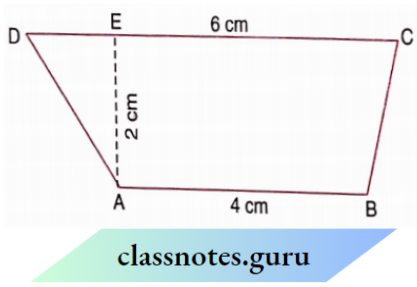Mensuration
Mensuration Introduction
We know that the perimeter of a closed figure is the distance around its boundary. Also, the area of a closed figure is the measurement of the region covered by it.
- Moreover, the volume of a solid is the amount of space occupied by it. We know how to find the areas and perimeters of various plane figures such as triangles, parallelograms, rectangles, rhombuses, squares, circles, pathways, and borders in rectangular shapes, etc.
- Here, we shall learn to solve the problems related to perimeters and areas of general quadrilaterals and trapeziums.
- We shall also learn to solve the problems related to areas of polygons (regular and irregular) by using the formula for the area of a triangle and that for the area of a trapezium.
- Moreover, we shall also learn to find out the surface areas, and volumes of cubes, cuboids, and cylinders.
Area Of A Polygon
We use the method of triangulation which means splitting into triangles.
Read and Learn More NCERT Solutions For Class 8 Maths
Question 1. Divide the following polygon (Figures) into parts (triangles and trapezium) to find out its area.

Solution:
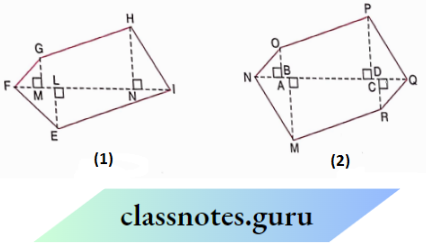
NCERT Solutions for Class 8 Maths Chapter 9 Mensuration
2. Polygon ABODE is divided into parts as shown below. Find its area ifAD = 8 cm, AH = 6 cm, AG = 4 cm, AF = 3 cm, and perpendiculars BF = 2 cm, CH = 3 cm, EG = 2.5 cm.
Solution:
Area of polygon ABCDE = Area of A AFB + Area of trapezium FBCH + Area of A CHD + Area of A ADE …..(1)
Area of Δ AFB = (I) =\(\frac{1}{2}\) x AF x BF = \(\frac{1}{2}\) x 3 x 2 = 3 cml2
Area of trapezium FBCH = (2) = FH x \(\frac{(\mathrm{BF}+\mathrm{CH})}{2}=3 \times \frac{(2+3)}{2}=7.5 \mathrm{~cm}^2\)
FH = AH-AF = 6- 3 = 3
Area of Δ CHD = (3) = \(\frac{1}{2} \times \mathrm{HD} \times \mathrm{CH}=\frac{2 \times 3}{2}=3 \mathrm{~cm}^2\)
HD = AD -AH = 8 – 6 = 2cm
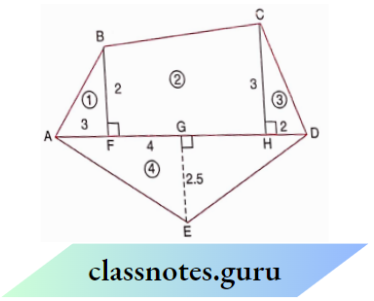
Area of Δ ADE = (4) \(\frac{1}{2} \times \mathrm{AD} \times \mathrm{GE}=\frac{1}{2}\) x 8 x 2.5 = 10 cm2
From (1),
Area of polygon ABCDE = Area [(1) + (2) + (3) + (4)]
= 3 + 7.5 + 3 + 10 = 23.5 cml2
3. Find the area of polygon MNOPQR (Figure), if
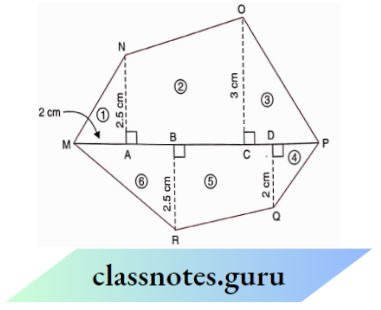
MP = 9 cm, MD = 7 cm, MC = 6 cm, MB – 4 cm, MA = 2 cm, NA, OC, QD, and RB are perpendicular to diagonal MP.
Solution:
Area of polygon MNOPQR
= Area of A MAN + Area of trapezium ACON + Area of A OOP + AreaofAPDQ + Area of trapezium DBRQ + AreaofARBM …(1)
Given:
MP = 9 cm, MD = 7 cm, MC = 6 cm, MB = 4 cm MA = 2 cm
Area of A MAN = (1) = \(\frac{\mathrm{MA} \times \mathrm{AN}}{2}=\frac{2 \times 2.5}{2}=2.5 \mathrm{~cm}^2\)
Area of trapezium ACON = (2) = \(\frac{(\mathrm{AN}+\mathrm{CO}) \times \mathrm{AC}}{2}=\frac{(\mathrm{AN}+\mathrm{CO}) \times(\mathrm{MC}-\mathrm{MA})}{2}\)
\(=\frac{(2.5+3) \times(6-2)}{2}=11 \mathrm{~cm}^2\)Area of A 0CP = (3) = \(\frac{\mathrm{CP} \times \mathrm{OC}}{2}=\frac{(\mathrm{MP}-\mathrm{MC}) \times \mathrm{OC}}{2}=\frac{(9-6) \times 3}{2}\) = 4.5 cml2
AreaofAPDQ = (4) = \(\frac{\mathrm{PD} \times \mathrm{DQ}}{2}=\frac{(\mathrm{MP}-\mathrm{MD}) \times \mathrm{DQ}}{2}=\frac{(9-7) \times 2}{2}\) = 2cm2
Area of trapezium DBRQ = (5) \(\frac{(\mathrm{DQ}+\mathrm{BR}) \times \mathrm{BD}}{2}=\frac{(2+2.5) \times(\mathrm{MD}-\mathrm{MB})}{2}\)
⇒ \(\frac{(2+2.5) \times(7-4)}{2}=6.75 \mathrm{~cm}^2\)
Area of ARBM= (6) =\(\frac{\mathrm{MB} \times \mathrm{RB}}{2}=\frac{4 \times 2.5}{2}=5 \mathrm{~cm}^2\)
From (1),
Area of polygon MNOPQR
= Area [(1) + (2) + (3)+ (4)+ (5) + (6)]
= 2.5 cml2 + 11cml2 + 4.5 cml2 + 2 cml2 + 6.75 cml2 + 5 cml2
= 31.75 cml2
Mensuration Exercise 9.1
Question 1. The shape of the top surface of a table is a trapezium. Find its area if its parallel sides are 1 m and 1.2 m and the perpendicular distance between them is 0.8 m.
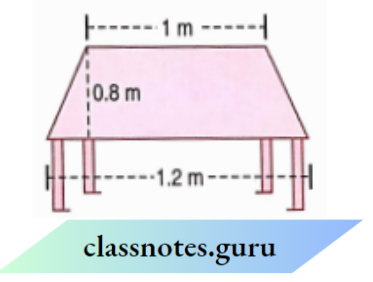
Solution:
Area of the top surface of the table
⇒ \(\frac{1}{2} h(a+b)\)
⇒ \(\frac{1}{2} \times 0.8 \times(1.2+1)\)
⇒ \(0.88 \mathrm{~m}^2\)
Class 8 Chapter 9 Maths NCERT Solutions PDF
Question 2. The area of the trapezium is 34 cm2, and the length of one of the parallel sides is 10 cm and its height is 4 cm. Find the length of the other parallel side.

Solution:
Let the length of the other parallel side be b cm
Area of trapezium = \(\frac{1}{2} h(a+b)\)
⇒ \(34 =\frac{1}{2} \times 4 \times(10+b)\)
⇒ \(34 =2 \times(10+b)\)
⇒ \(10+b =\frac{34}{2}\)
10 + b = 17
b = 17 – 10
b = 7cm
Hence, the length of another parallel side is 7cm
Question 3. The length of the fence of a trapezium-shaped field ABCD is 120 m. If BC = 48 m, CD = 17 m, and AD = 40 m, find the area of this field. Side AB is perpendicular to the parallel sides AD and BC.
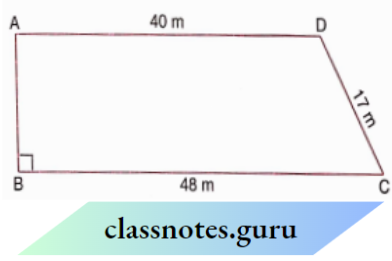
Solution:
The fence of the trapezium-shaped field
ABCD = 120 m
AB + BC + CD + DA = 120
AB + 48 + 17 + 40 = 120
AB + 105 = 120
AB = 120 – 105
AB = 15 m
Area of the field
⇒ \(\frac{(B C+A D) \times A B}{2}\)
⇒ \(\frac{(48+40) \times 15}{2}=660 \mathrm{~m}^2 .\)
Hence, the area of the trapezium-shaped field is 660 ml2
Question 4. The diagonal of a quadrilateral-shaped field is 24 m and the perpendiculars dropped on it. from the remaining opposite vertices are 8 m and 13 m. Find the area, of the field
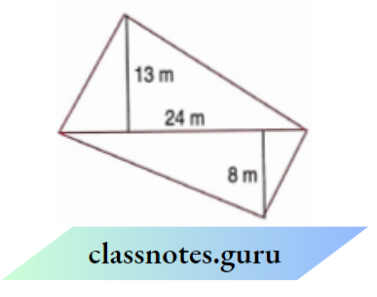
Solution: Area of the field
⇒ \(\frac{1}{2} d\left(h_1+h_2\right)\)
⇒ \(\frac{24 \times(8+13)}{2}=\frac{24 \times 21}{2}\)
= 12 x 21 = 252 ml2.
Hence, the area of the quadrilateral-shaped field is 252 ml2.
Question 5. The diagonals of a rhombus are 7.5 cm and 12 cm. Find its area.
Solution:
Area of the rhombus

⇒ \(\frac{1}{2} \times d_1 \times d_2=\frac{1}{2} \times 7.5 \times 12\)
= 45cml2
Hence, the area of the rhombus is 45cml2
Question 6. Find the area of a rhombus whose side is 5 cm. and whose altitude is 4.8 cm. If one of its diagonals is 8 cm long, find the length of the other diagonal.
Solution:
Area of the rhombus
= base (b) x altitude (h)
= 5 x 4.8 = 24 cml2
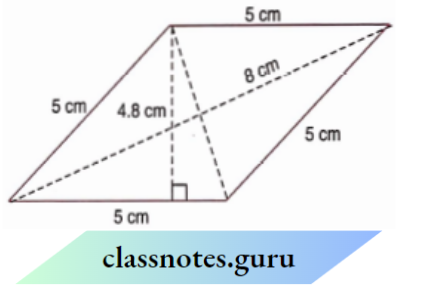
Area of the rhombus
⇒ \(\frac{1}{2} \times d_1 \times d_2\)
⇒ \(24 =\frac{1}{2} \times 8 \times d_2\)
⇒ \(24 =4 d_2\)
⇒ \(d_2 =\frac{24}{4}=6 \mathrm{~cm}\)
Hence, the length of the other diagonal of a rhombus is 6 cm.
Mensuration Class 8 NCERT Question Answer
Question 7. The floor of a building consists of 3,000 tiles which are rhombus shaped and each of its diagonals are 45 cm and 30 cm in length. Find the total cost of polishing the floor if the cost per m2 is 4.
Solution:
Area of a tile = \(=\frac{1}{2} \times d_1 \times d_2=\frac{1}{2} \times 45 \times 30\)
= 675 cm2
Area of the floor = 675 x 3,000 cm2 = 20,25,000 cm2
⇒ \(\frac{20,25,000}{100 \times 100} \mathrm{~m}^2\)
lm2 = 100 X 100 cml2
202.50 ml2
The cost of polishing per ml2 = 4
Total cost of polishing the floor
= 202.50 x 4
= $ 810.
Hence, the total cost of polishing the floor is? 810
Question 8. Mohan wants to buy a trapezium field. Its side along the river is parallel to and twice the side along the road. If the area of this field is 10,500 m2 and the perpendicular distance between the two parallel sides is 100 m., find the length of the side along the river.

Solution:
Let the length of the side along the road be m. Then, the length of the side along the river is 2x m.
Area of the field = 10,500square meters
⇒ \(\frac{1}{2} h(a+b)=10500\)
⇒ \(\frac{100 \times(2 x+x)}{2}=10,500\)
⇒ \(150 x =10,500\)
⇒ \(x =\frac{10,500}{150}\)
x= 70
2x = 2 x 70 = 140m
Hence, the length of the side along the river is 140 m.
Question 9. The top surface of the raised platform is in the shape of a regular octagon as shown in the figure. Find the area of the octagonal surface.
Solution:
Area of the octagonal surface
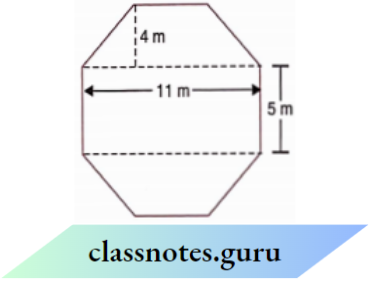
= Area of rectangular surface + 2(Area of trapezoidal surface)
Since the octagon is regular, therefore, the two trapeziums will be congruent.
Hence, their surface area of 111 will be equal.
⇒ \(11 \times 5+2 \times\left[\frac{(5+11) \times 4}{2}\right] \mathrm{m}^2\)
55 + 64 m2 = 119 ml2
Question 10. There is a pentagonal-shaped park as shown in the figure. ForfindingitsareaJyoti and Kavita divided it into two different ways
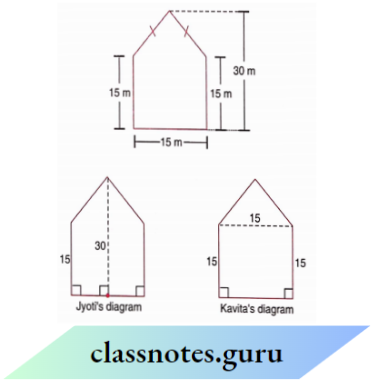
Find the area of this park using both ways. Can you suggest some other way offind¬ ing its area?
Solution: Jyoti’s diagram
Here, the pentagonal shape is split into two congruent trapeziums.
Area of the park
⇒ \(2 \times\left[\frac{(15+30)}{2} \times \frac{15}{2}\right]\)
⇒ \(\frac{675}{2}\)
= 337.5 m2
Kavita’s diagram:
Here, the pentagonal shape is split into a square and a triangle.
Area of the park
= Area of square + Area of triangle
⇒ \(=15 \times 15 \mathrm{~m}^2+\frac{15 \times(30-15)}{2} \mathrm{~m}^2\)
⇒ \(=225 \mathrm{~m}^2+\frac{225}{2} \mathrm{~m}^2\)
= 225 m2 + 112.5 ml2
= 337.5 ml2
Another way of finding the area
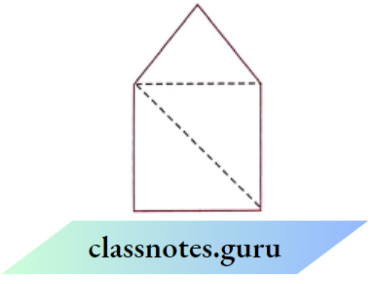
Here, the pentagonal shape is split into three triangles, out of which two triangles are congruent.
Area of the park \(=\frac{15 \times(30-15)}{2} \mathrm{~m}^2 +2 \times\left[\frac{15 \times 15}{2}\right] \mathrm{m}^2 \)
Class 8 Maths Chapter 9 Solutions with Explanation
Question 11. The diagram of the adjacent picture frame has outer dimensions = 24 cm x 28 cm and inner dimensions 16 cm x 20 cm. Find the area of each section of the frame, if the width of each section is the same

Solution:
Area of the right section of the frame
⇒ \(\frac{28+20}{2} \times \frac{24-16}{2} \mathrm{~cm}^2\)
⇒ \(\frac{48}{2} \times \frac{8}{2}=24 \times 4=96 \mathrm{~cm}^2\)
The section is a trapezium
Similarly, the area of the left section of the frame = 96 cm2
The area of the upper section of the frame
⇒ \(\frac{24+16}{2} \times \frac{28-20}{2} \mathrm{~cm}^2\)
⇒ \(\frac{40}{2} \times \frac{8}{2}=20 \times 4 \mathrm{~cm}^2\)
= 80 cml2
Similarly, the area of the lower section of the frame
= 80 cml2
Solid Shapes
Two-dimensional figures are the faces of three-dimensional shapes. If two faces of a shape are identical, then they are called congruent faces.
Surface Area Of Cube, Cuboid, And Cylinder
The surface area of a solid is the sum of the areas of its faces.
Mensuration Cuboid
Total surface area of a cuboid = 2 (lb + bh + hl)
where l, b, and h are the length, width, and height of the cuboid, respectively
Question: Find the total surface area of the following cuboids (Figure):

Solution:
The total surface area of the first cuboid
= 2(lb + bh + hi)
= 2(6 x 4 + 4 x 2 + 2 x 6)
= 2(24 + 8 + 12) = 88 cml2
The total surface area of the second cuboid
= 2(lb+ bh + hi)
= 2(4 x 4 + 4 x 10 + 10 x 4)
= 2(16 + 40 + 40) = 192 cml2
Class 8 Mensuration Exercise-wise Solutions
Question 1 . Cover the lateral surface of a cuboidal duster (which your teacher uses in the classroom) using a strip of brown sheet of paper, such that it just fits around the surface. Remove the paper. Measure the area of the paper. Is it the lateral surface area of the duster?
Solution:
(i) Yes, we can say that the area of this strip of brown sheet paper is equal to the lateral surface area of the duster.
Question 2. Measure the length, width, and height of your classroom and find
- The total surface area of the room, ignoring the area of windows and doors.
- The lateral surface area of this room.
- The total area of the room which is to be white-washed.
Solution:
2. Please find yourself
Question 3. Can we say that the total surface area of a cuboid
= lateral surface area + 2 x area of base?
Question 4. If we interchange the lengths of the base and the height of a cuboid to get another cuboid, will its lateral surface area change?
Solution:
1. Yes, we can say that the total surface area of a cuboid
= lateral surface area + 2 x area of base.
2. Lateral surface area of cuboid (i) = 2(1 + b) h
The lateral surface area of the cuboid (ii)
= 2(h + b) l. These results are different.
Hence, yes; the lateral surface area will change if we interchange the length of the base and the height of a cuboid

Mensuration Cube
The total surface area of a cube = 6l2, where l is the side of the cube. The lateral surface area of a cube = 4l2, where l is the side of the cube.
Question: Draw the pattern shown on a squared paper and cut it out. (You know that this pattern is a net of a cube). Fold it along the lines and tape the edges to form a cube.
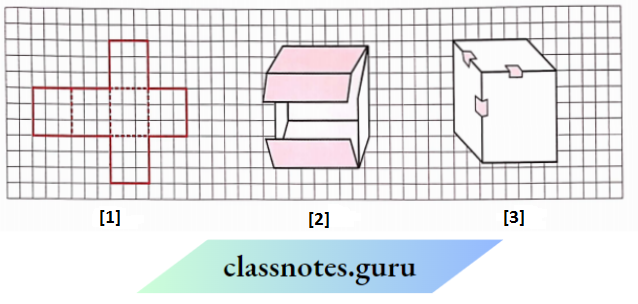
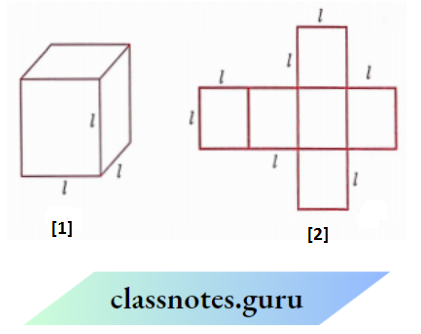
- What is the length, width, and height of the cube? Observe that all the faces of a cube are square. This makes the length, height, and width of a cube equal.
- Write the area of each of the faces. Are they equal?
- Write the total surface area of this cube
- If each side of the cube is l, what will be the area of each face?
- Can we say that the total surface area of a cube of side l is 6l2?
Solution:
(a) Length of the cube
= Width of the cube
= Length of the cube of side s
Area of each face = l x l = l2.
Yes, they are equal.
(c) Total surface area of this cube = 6l2.
Area of each face = l2.
Yes, we can say that the total surface area of a cube of side l is 6l2
10. Find the surface area of Cube A and the lateral surface area of Cube B.
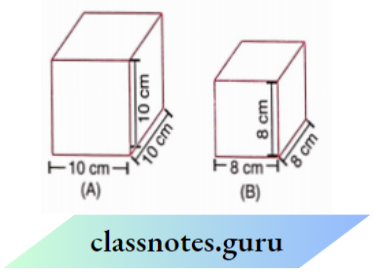
Solution:
The surface area of the cube (A)
= 6l2
= 6(10)2cm2
= 600 cm2
The lateral surface area of the cube (B)
= 4l2
= 4 x 8 x 8cm2
= 256 cm2
Question .1 Two cubes each with side b are joined to form a cuboid (Figure). What is the surface area, of this cuboid?
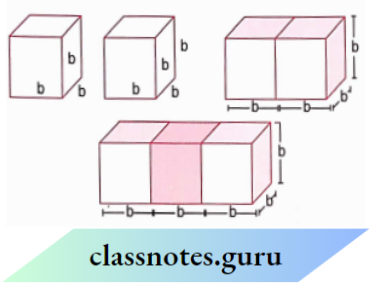
How will you arrange 12 cubes of equal length to form a cuboid of the smallest surface area?

After the surface area of a cube is painted, the cube is cut into 64 smaller cubes of the same dimensions (Figure).
How many have no face painted? 1 face painted? 2faces painted? 3faces painted?
Solution:
By joining two cubes on each side b,
we get a cuboid whose
length (L) = b + b = 2b units
breadth (B) = b units
and height (H) = b units
The surface area of this cuboid
= 2(L x B + B x H + H x L)
= 2[2b x b + b x b + b x 2b] sq. units
= 2[2b2 + b2 + 2b2 sq. units
= 10b2 sq. units
≠ 12b2. (No, it is not equal to 1262)
Again, by joining three cubes, each with ® side b, we get a cuboid whose
length (L) = 6 + 6 + 6 = 36 units
breadth (B) = 6 units
height (H) = 6 units
The surface area of the cuboid formed by joining the three cubes
= 2 (L x B + B x H + H x L)
= 2 x [3b x b + b x b + b x 3b] sq. units
= 2 x [3b2 + b2 + 3b2] sq. units
= 14b2 sq. units
≠1862(No, it is not equal to 18b2)
(ii) In the first arrangement,
L = 66, B = 26, H = 26

Surface area
= 2 x (6b x 2b + 2b x 2b + 2b x 6b)
= 2 x (12b2 + 4b2 + 12b2)
= 56b2
In the second arrangement,
L = 4b
B = 6
H = 3b
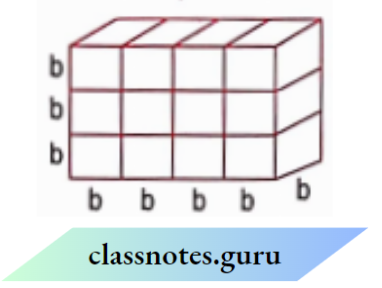
Surface area
= 2 x (4b x b + b x 3b + 3b x 4b)
= 2 x (4b2 + 3b2 + 12b2)
= 38b2
Hence, for the smallest surface area, the second arrangement must be made.
(Hi) 16 cubes have no faces painted.
24 cubes have 1 face painted.
16 cubes have 2 faces painted.
8 cubes have 3 faces painted.
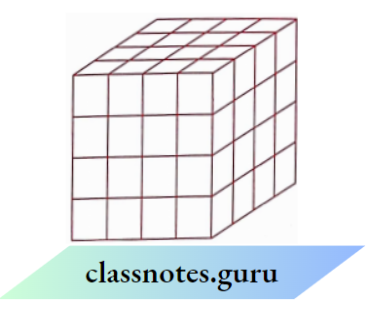
CBSE Class 8 Maths Chapter 9 Solutions
Mensuration Cylinders
Formulae :
The lateral (curved) surface area of a cylinder = 2kvh
Total surface area of a cylinder = 2nr (h + r)
where r is the radius of the base and h is the height of the cylinder.
We take n to be \(\frac{22}{7}\) unless otherwise stated
Question .1 Find the total surface area of the following cylinders.
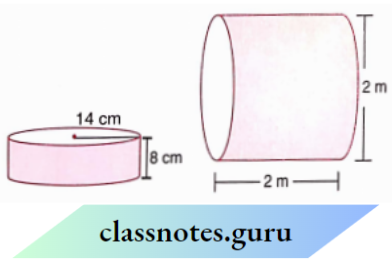
Solution:
For the First Cylinder
r = 14 cm
h = 8 cm
Total surface area of the cylinder = 2nr(r + h)
\(=2 \times \frac{22}{7} \times 14 \times(14+8) \mathrm{cm}^2\)= 2 x 22 x 2 x 22 = 88 x 22
= 1936 cm2
For the Second Cylinder
\(r=\frac{2}{2} \mathrm{~m}=1 \mathrm{~m}\)h = 2 m
The total surface area of the cylinder
= 2πr (r + h)
⇒ \(2 \times \frac{22}{7} \times 1 \times(1+2) \mathrm{m}^2\)
⇒ \(\frac{132}{7} \mathrm{~m}^2=18 \frac{6}{7} \mathrm{~m}^2\)
Question 2. Note that the lateral surface area of a cylinder is the circumference of the base x the height of the cylinder. Can. We write the lateral surface area of the cuboid as the perimeter of the base x height of the cuboid.
Solution:
Lateral surface area
= 2 x [(l x h) + (b x h)]
= 2 (l + b) x h
= Perimeter of base b x height of the cuboid
Yes, we can write the surface area of a cuboid as
perimeter of base x height of the cuboid
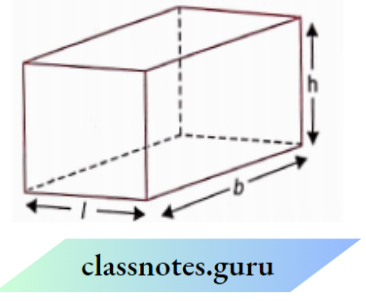
Mensuration Exercise 9.2
Question 1. There are two cuboidal boxes as shown in the adjoining figure. Which box requires a lesser amount of material to make?

Solution:
First Cuboidal Box
l = 60 cm, b = 40 cm, h = 50 cm
Total surface area
= 2(lb + bh + hl)
= 2(60 x 40 + 40 x 50 + 50 x 60) cm2
= 2(2400 + 2000 + 3000) cm2
= 2(7400) cm2
= 14800 cm2
Second Cuboidal Box
l = 50 cm, b = 50 cm, h = 50 cm
Total surface area
= 2(lb + bh + hl)
= 2(50 x 50 + 50 x 50 + 50×50) cm2
= 2(2500 + 2500 + 2500) cm2
= 2(7500) cm2
= 15000 cm2
Since the total surface area of the first cuboidal box is less than the total surface area of the second cuboidal box, therefore, box (a) requires a lesser amount of material to make.
NCERT Class 8 Mensuration Chapter Questions
Question 2. A suitcase with measures 80 cm x 48 cm x 24 cm is to be covered with a tarpaulin cloth. How many meters of tarpaulin of width 96 cm are required to cover 100 such suitcases?
Solution:
Here,
Length of the suitcase (l) = 80 cm
The breadth of the suitcase (b) = 48 cm
Height of the suitcase (h) = 24 cm
The total surface area of the suitcase
= 2(lb + bh + hl)
= 2(80 x 48 + 48 x 24 + 24 x 80) cm2
= 2(3840 + 1152 + 1920) cm2
= 2(6912) cm2
= 13824 cm2
Width of tarpaulin = 96 cm
Length of tarpaulin required to cover 1 suitcase
⇒ \(\frac{\text { Total surface area of the suitcase }}{\text { Width of tarpaulin }}\)
⇒ \(=\frac{13824}{96}=144 \mathrm{~cm}\)
Length of tarpaulin required to cover 100 such suitcases
= 144 x 100 cm = 14400 cm
⇒ \(\frac{14400}{100} \mathrm{~m}=144 \mathrm{~m}\)
Hence, 144 m of tarpaulin is required.
Question 3. Find the side of a cube whose surface area is 600 cm2.
Solution:
Let the side of the cube be a cm. Then, the total surface area of the cube
= 6a2 cm2
According to the question,6a2 = 600
⇒ \(a^2=\frac{600}{6}\)
a2= 100
a = √1oo
a = 10 cm
Hence, the side of the cube is 10 cm.
Question 4. Rukhsar painted the outside of the cabinet measuring 1 m x 2 m x 1.5 m. How much surface area did she cover if she painted all except the bottom of the cabinet?
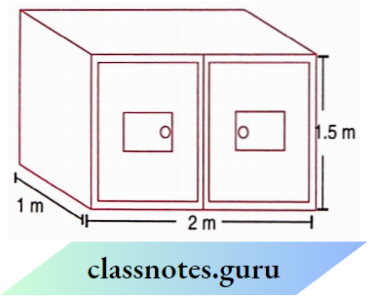
Solution:
I = 2m 7 cm
b = 1 m
h = 1.5 m
Required area
= 2[2 x 1 + 1 x 1.6 + 1.5 x 2] -2xl
= 2[2 +1.5 + 3] – 2
= 13 m2-2 m2
= 11 m2
Hence, she covered 11 m2 of surface area.
Question 5. Daniel is painting the walls and ceiling of the cuboidal hall with a length, breadth, and height of 15 m, 10 m, and 1 m, respectively. From each can of paint, 100 m2 of area is painted. How many cans of paint will she need to paint the room?
Solution:
Z = 15 m
b = 10 m
h = 7 m
Surface area to be painted
= 2(1 x 6 + b x h + h x l) – l x b
= 2 (15 x 10 + 10 x 7 + 7 x 15) m2 – (15 x 10) m2
= 2(150 + 70 + 105) m2 – 150 m2
= 2(325) m2 – 150 m2
= 650 m2 – 150 m2
= 500 m2
Number of cans needed \(=\frac{\text { Surface area to be painted }}{\text { Area painted by } 1 \text { can }}\)
⇒ \(=\frac{500}{100}=5\)
Hence, she will need 5 cans of paint to paint the room.
Question 6. Describe how the two figures (below) are alike and how they are different. Which box has a larger lateral surface area?
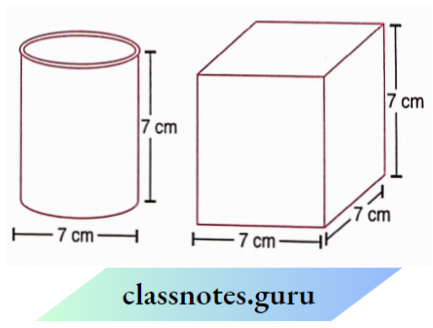
Solution:
Likeness→ Both have the same height.
Difference → One is a cylinder, the other is a cube;
The cylinder is a solid obtained by revolving a rectangular area about one side.
A cube is a solid enclosed by six square faces.
A cylinder has two circular faces, whereas a cube has six square faces
For First Box
Diameter = 7 cm
Radius (r) =\(\frac{\text { Diameter }}{2}=\frac{7}{2} \mathrm{~cm}\)
Height (h) = 7 cm
Lateral surface area = 2nrh
⇒ \(2 \times \frac{22}{7} \times \frac{7}{2} \times 7\) = 154 cm2
For the Second Box
l = 7 cm
b = 7 cm
h = 7 cm
Lateral surface area
= 4 = 4 x (7)2
= 196cm2
Hence, the second box has a larger lateral surface area
Class 8 Chapter 9 Surface Area and Volume
Question 7. A closed cylindrical tank of radius 7 m and height 3 m is made from a sheet of metal. How much sheet of metal is required?
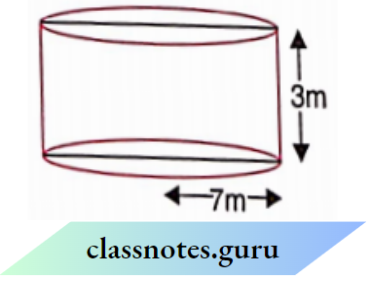
Solution:
r = 7 m
h = 3 m
Total surface area
= 2πr(r + h)
⇒ \(2 \times \frac{22}{7} \times 7 \times(7+3)\) = 440 m2
Hence, 440 m2 of metal sheet is required.
Question 8. The lateral surface area of a hollow cylinder is 4224 cm2. It is cut along its height and forms a rectangular sheet of width 33 cm. Find the perimeter of the rectangular sheet.
Solution:
The lateral surface area of the hollow
cylinder = 4224 cm2
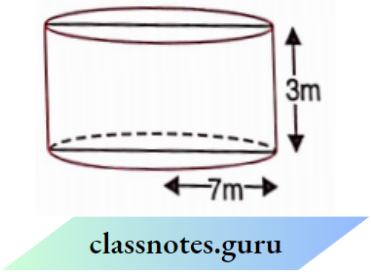
The area of the rectangular sheet = 4224 cm2
Length x width = 4224 cm2
Length x 33 = 4224
Length = \(\frac{4224}{33}\)
Length = 128 cm
The perimeter of the rectangular sheet
= 2(Length + Breadth)
= 2(128 + 33) cm
= 2(161) cm
= 322 cm
Hence, the perimeter of the rectangular sheet is 322 cm.
Question 9. A road roller takes 750 complete revolutions to move once over to level a road. Find the area of the road if the diameter of a road roller is 84 cm and the length is 1 m.
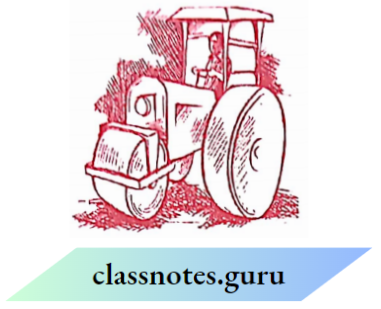
Solution:
The diameter of the road roller = 84 cm
Radius (r) of the road roller \(\frac{84}{2} \mathrm{~cm}=42 \mathrm{~cm}\)
Length (h) of the road roller = 1 m = 100 cm
The lateral surface area of the road roller = 2πrh
⇒ \(2 \times \frac{22}{7} \times 42 \times 100\)
= 26,400 cm2
The area of the road is covered in 1 complete revolution
= 26,400 cm2
The area of the road covered 750 complete revolutions
= 26,400 x 750 cm2
= 1,98,00,000 cm2
⇒ \(\frac{1,98,00,000}{100 \times 100} \mathrm{~m}^2\)
= 1,980 m2
Question 10. A company packages its milk powder in a cylindrical container whose base has a diameter of 14 cm and a height of 20 cm. The company places a label around the surface of the container (as shown in the figure). If the label is placed 2 cm from the top and bottom, what is the area of the label
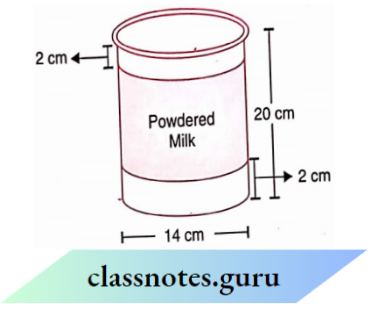
Solution:
For a cylindrical container
The diameter of the base = 14 cm
Radius of the base (r) =\(\frac{14}{2} \mathrm{~cm}\)
= 7 cm
Height (h) = 20 cm
The curved surface area of the container = 2πrh
⇒ \(=2 \times \frac{22}{7} \times 7 \times 20\)
= 880 cm2
Surface area of the label
= 880 cm2
⇒ \(-2\left(2 \times \frac{22}{7} \times 7 \times 2\right) \mathrm{cm}^2\)
= 880 cm2 – 176 cm2
= 704 cm2
Hence, the surface area of the label is 704 cm2.
Aliter:
The label is in the form of a cylinder for which
radius (R) =\(\frac{14}{2}=7 \mathrm{~cm}\)
height (H) = 20 – (2 + 2) = 16 cm
Area of the label = 2πRH
⇒ \(=2 \cdot \frac{22}{7} \cdot 7 \cdot 16=704 \mathrm{~cm}^2\)
Hence, the surface area of the label is 1704 cm2.
Class 8 Mensuration Worksheet with Answers
Volume Of Cube, Cuboid, And Cylinder
The volume of a three-dimensional object is the amount of space occupied by it. Volume is measured in cubic units.
Question 1 cubic cm
= 1 cm x 1 cm x 1 cm
= 1 cm3
= 10 mm x 10 mm x 10 mm
= mm3
1 cubic m
= lm x lm x lm = lm3
1 cubic mm
= 1 mm x l mm x 1 mm 1 cubic mm
= 1 mm3
= 0.1 cm x 0.1 cm x 0.1 cm
cm3
1 cubic mm
= 1 mm x l mm x 1 mm 1 cubic mm
= 1 mm3
= 0.1 cm x 0.1 cm x 0.1 cm
=100cm3
1 cubic mm
= 1 mm x l mm x 1 mm 1 cubic mm
= 1 mm3
= 0.1 cm x 0.1 cm x 0.1 cm
cm3
Cuboid Formula
Volume of cuboid = Ibh
where l, b, and h are the length, width, and height of the cuboid, respectively.
OR
The volume of the cuboid = area of the base x height cuboid.
YouTakecan36arrangecubes of the qualm size many(ie., ways.lengthObserveofeachthecubefollowingis same. table Arrange and fill the min the to blank torn a
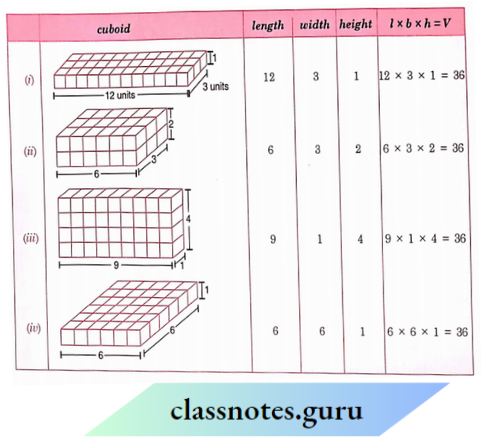
We have the following observations:
Since then, we have used 36 cubes of equal size to form these 36 cubic units. Also, the volume of each cuboid is the height of the cuboid. From the above example ese cuboids, the volume of each cuboid = l x b x h
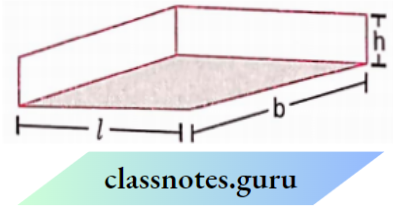
Since l x b is the area of its b
The volume of a cuboid = Area of base x Therefore, we can also say that,
Question 1. Can you think of such objects whose
Solution: The volume of Godow reservoirs, etc., can be found by this method.
Question: Find the volume of the following cuboids (Figure).

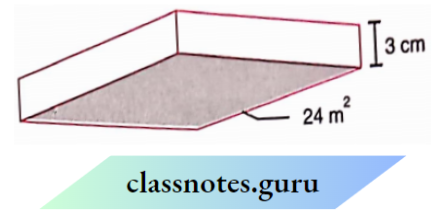
Solution:
(i) Volume of the cuboid
= l x b x h
= (8x3x2) cm3
= 48 cm3
(ii) Volume of the cuboid
= Area of Base x Height
⇒ \(24 \times \frac{3}{100}\)
⇒ \(\frac{72}{100}=0.72 \mathrm{~m}^3\)
Cube
The volume of the cube = 13, where l is the side of the cube.
Question 1. Find the volume of the following cubes.
- with a side of 4 cm
- with a side of 1.5 m
Solution:
Volume of the cube = (Side)3
= 4 x 4 x 4 cm3
= 64 cm3
(b) Volume of the cube = (Side)3
= 1.5 x 1.5 x 1.5 m3
= 3.375 m3
NCERT Solutions for Class 8 Maths Chapter 9 Mensuration
Question 2. Arrange 64 cubes of equal size in as many ways as you can to form a cuboid. Find the surface area of each arrangement. Can solid shapes of the same volume have the same surface area?
Solution:
Some arrangements are as follows :
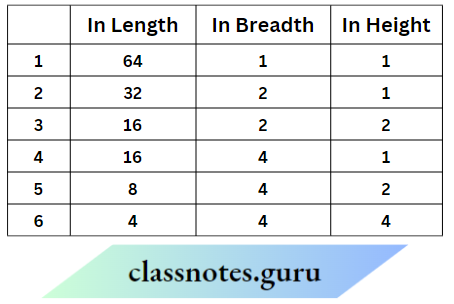
The surface area in the arrangement
(1) = 2 x (64 x l + i x l + l x 64)
258 square units
2 x (32 x 2 + 2 x l + i x 32)
= 196 square units
= 2 x (16 x 2 + 2 x 2 + 2 x 16)
= 136 square units
= 2 x (16 x 4 + 4 x 1 + 1x 16)
= 168 square units
=2 x (8 x 4 + 4 x 2 + 2 x 8) = 112 square units
= 2 x (4 x 4 + 4 x 4 + 4 x 4)
= 96 square units, etc.
Also, the volume of the cuboid obtained in each case is 64 cubic units. So, No, we cannot say that solid shapes of the same volume need to have the same surface area.
Question 3. The company sells biscuits. For packing purposes, they are using cuboidal boxes :
box A → 3 cm x 8 cm x 20 cm,
box B → 4 cm x 12 cm x 10 cm.
- What size of the box will be economical for the company? Why?
- Can you suggest any other size (dimensions) that has the same volume but is more economical than these?
Solution:
Box A: Total surface area
= 2 x (3 x 8 + 8 x 20 + 20 x 3) cm2
= 2 x (24 +160 + 60) cm2
= 2 x 244 cm2 = 488 cm2
Box B: Total surface area
= 2 x (4 x 12 + 12 x 10 + 10 x 4) cm2
= 2 x (48 + 120 + 40) cm2
= 2 x208 cm2 = 416 cm2.
-Since the total surface area of box B is lesser than the total surface area of box A, therefore, the size of 4 cm x 12 cm x 10 cm of the
The box will be economical for the company to use for packing purposes.
(The volume of both the boxes are same as given below)
Again, the volume of the cuboidal box A
= 3 x 8 x 20
= 480 cm3 and, volume of the cuboidal box B
= 4 x 12 x 10
= 480 cm3
Yes, we can suggest another size (dimensions) which has the same volume but is more economical than these. It is 10 m x 6 m x 8 m.
Volume = 10 x 6 x 8 = 480 cm3
Total surface area = 2 x (10 x 6 + 6 x 8 + 8 x 10) cm2 = 376 cm2.
This size (dimensions) has the same volume, but it is more economical than boxes A and B.
Cylinder Formula:
Volume of cylinder = πr2h
where r is the radius of the base and h is the height of the cylinder
Question 1. Find the volume of the following cylinders :
Solution:
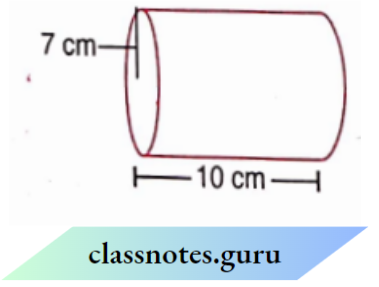

r = 7 cm, h = 10 cm
The volume of the cylinder = πr2h
⇒ \(=\frac{22}{7} \times 7^2 \times 10\)
⇒ \(=\frac{22}{7} \times 7 \times 7 \times 10\)
= 1540 cm3
The Volume of the cylinder
= Area of base x height
= (250 x 2) m3
= 500 m3
Volume And Capacity
There is not much difference between these two words.
Volume refers to the amount of space occupied by an object.
Capacity refers to the quantity that a container holds.
Note: If a water tin holds 100 cm3 of water, then the capacity of the water tin is 100 cm3.
Capacity is also measured in terms of liters.
The relation between liter and cm3 is,
1 mL = 1 cm3, 1 L = 1000 cm3.
lm3 = 10,00,000 cm3= 1000 L.
Mensuration Exercise 9.3
Question 1. Given a cylindrical tank, in which situation will you find the surface area, and in which situation is volume?
- To find how much it can hold,
- The number of cement bags required to plaster it.
- To find the number of smaller tanks that can be filled with water from it.
Solution:
Volume
Surface area
Volume.
Question 2. The diameter of cylinder A is 7 cm, and the height is 14 cm. The diameter of cylinder B is 14 cm, and the height is 7cm. Without doing any calculations, can you suggest whose volume is greater? Verify it by finding the volume of both cylinders. Check whether the cylinder with greater volume also has a greater surface area.
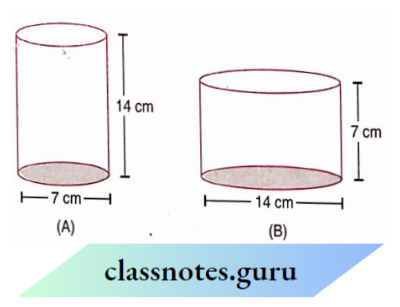
Solution:
The volume of cylinder B is greater.
For Cylinder A
⇒ \(r=\frac{7}{2} \mathrm{~cm}\)
h = 14 cm
Volume = nr2h
⇒ \(=\frac{22}{7} \times \frac{7}{2} \times \frac{7}{2} \times 14\)
= 539 cm3
For Cylinder B
⇒ \(r=\frac{14}{2} \mathrm{~cm}=7 \mathrm{~cm}\)
h = 7 cm
Volume = nr2h
⇒ \(\frac{22}{7} \times 7 \times 7 \times 7\)
= 1078 cm3.
By actual calculation of volumes of both the cylinders, it is verified that the volume of cylinder B is greater
Surface Area
For Cylinder A
Surface area = 2jir (r + h)
⇒ \(2 \times \frac{22}{7} \times \frac{7}{2} \times\left(\frac{7}{2}+14\right)\)
⇒ \(2 \times \frac{22}{7} \times \frac{7}{2} \times \frac{35}{2}\)
= 385 cm2
For Cylinder B
Surface area
=27tr(r + h)
⇒ \(2 \times \frac{22}{7} \times 7 \times(7+7)\)
⇒ \(2 \times \frac{22}{7} \times 7 \times 14\)
By actual calculation of the surface area of both cylinders, we observe that the cylinder with greater volume (Cylinder B) has a greater surface area.
Class 8 Maths Mensuration Chapter Solutions
Question 3. Find the height of a cuboid whose base area is 180 cm2 and volume is 900 cm3.
Solution:
Height of the cuboid = \(=\frac{\text { Volume of the cuboid }}{\text { Base area of the cuboid }}\)
⇒ \(=\frac{900}{180}\) = 5 cm
Question 4. A cuboid is of dimensions 60 cm x 54 cm x 30 cm. How many small cubes with sides 6 cm can be placed in the given cuboid?
Solution:
Volume of the cuboid = 60 x 54 x 30 cm3
= 97200 cm3
The volume of a small cube
= 6 x 6 x 6 cm3
= 216 cm3
Number of small cubes that can be placed in the given cuboid
⇒ \(\frac{\text { Volume of the cuboid }}{\text { Volume of a small cube }}\)
⇒ \(\frac{97200}{216}=450\)
Hence, 450 small cubes can be placed in the given cuboid.
Question 5. Find the height of the cylinder whose volume is 1.54 m2 and whose diameter of the base is 140 cm.
Solution:
The diameter of the base = 140 cm
Radius of the base (r)= \(=\frac{140}{2} \mathrm{~cm}=70 \mathrm{~cm}\)
Area of the base = nr2
⇒ \(=\frac{22}{7} \times 70 \times 70\)
= 15400 cm2
The volume of the cylinder
= 1.54 m3
= 1.54 x 100 x 100 x 100 cm3
= 15,40,000 cm3
Height of the cylinder
⇒ \(\frac{\text { Volume of the cylinder }}{\text { Area of the base of the cylinder }}\)
⇒ \(\frac{(2)}{(1)}\)
⇒ \(=\frac{15,40,000}{15400}\)
= 100 cm
= 1 m
Hence, the height of the cylinder is 1 m.
Question 6. A milk tank is in the form of a cylinder whose radius is 1.5 m and length is 7 m. Find the quantity of milk in liters that can be stored in the tank
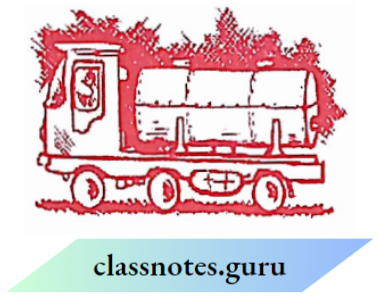
solution:
For milk tank
r = 1.5 m
h = 7 m
Capacity = nFh
⇒ \(=\frac{22}{7} \times 1.5 \times 1.5 \times 7\)
⇒ \(=\frac{22}{7} \times \frac{15}{10} \times \frac{15}{10} \times 7\)
= 49.5 m3 I
= 49.5 x 1000 L I
[lm3 = 1000 L]
= 49500 L.
Hence, the quantity of milk that can be stored in the tank is 49500 litres.
Question 7. If each edge of a cube is doubled,
- how many times will its surface area increase?
- how many times will its volume increase?
Solution:
Let the original edge of the cube be a cm.
Then, its new edge = 2a cm
The original surface area of the cube = 6a2 cm2
The new surface area of the cube
= 6(2a)2 cm2
= 24a2 cm2
= 4 (6a2 cm2)
= 4 original surface area,
Hence, its surface area will increase 4 times.
Originalvolume ofthe cube = a3 cm3
A new volume of the cube
= (2a)3 cm3
= 8a3 cm3
= 8 x the original volume of the cube.
Hence, its volume will increase 8 times
Question 8. Water is poured into a cuboidal g reservoir at the rate of 60 liters per minute. If the volume of the reservoir is 108 m3, find the BL number of hours it will take to fill the reservoir

Solution:
Volume of reservoir
= 108 m3
= 108 x 1000 L
[1 m3 = 1000 L]
= 108000 L
Water poured per minute = 60 L
Time taken to fill the reservoir
⇒ \(\frac{\text { Volume of the reservoir }}{\text { Water poured per minute }}\)
⇒ \(\frac{108000}{60} \mathrm{~m}\)
⇒ \(\frac{108000}{60 \times 60} \text { hours }\)
= 30 hours
Hence, the number of hours it will take to fill the reservoir is 30
Mensuration Class 8 NCERT Question Answer
Mensuration Multiple-Choice Questions and Solutions
Question 1. 1 cm3 =
- 1000 mm3
- 100 mm3
- 10 mm3
- \(\frac{1}{1000} \mathrm{~mm}^3 .\)
Solution: 1. 1000 mm3
Question 2. 1 m3 =
- 1000000 cm3
- 100 cm3
- 10 cm3
- \(\frac{1}{1000} \mathrm{~cm}^3 .\)
Solution: 1. 1000000 cm3
Question 3. 1 mm3 =
- 0.001 cm3
- 0.01cm3
- 0.1 cm3
- 100 cm3
Solution: 1. 0.001 cm3
Question 4. 1 cm3 =
- 0.000001m3
- 0.01m3
- 0.1m3
- 1000m3
Solution: 1. 0.000001m3
Question 5. The surface area of a cuboid of length l, breadth b, and height h is
- lbs
- lb + bh + hl
- 2 (lb + bh + hi)
- 2 (l+ b)h.
Solution: 3. 2 (lb + bh + hi)
Question 6. The surface area of a cube of edge a is
- 4a2
- 6a2
- 3a2
- a2
Solution: 2. 6a2
Question 7. The total surface area of a cylinder of base radius r and height h is
- 2πr (r + h)
- πr (r + h)
- 2πrh
- 2πr2
Solution: 1. 2πr (r + h)
Question 8. The volume of a cuboid of length l, breadth b, and height h is
- lbh
- lb + bh + hl
- 2 (lb + bh + hl)
- 2(l + b)h.
Solution: 1. lb
Question 9. The volume of a cube of edge a is
- a2
- a3
- a4
- 6a2
Solution: 2. a3
Question 10. The volume of a cylinder of base radius and height his
- 2πrh
- πr2h
- 2πr (r + h)
- \(\frac{1}{3} \pi r^2 h .\)
Solution: 2. nr2h
Question 11. 1 L =
- 10 cm3
- 100 cm3
- 1000 cm3
- 10000 cm3
Solution: 3. 1000 cm3
Question 12. 1 m3 =
- 1L
- 10 L
- 100L
- 1000 L
Solution: 4. 1000 L
Question 13. The area ofthe trapezium
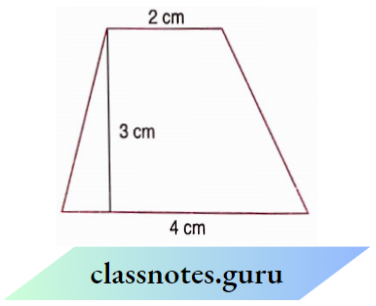
- 9 cm2
- 6 cm2
- 7 cm2
- 24 cm2
Solution: 1. 9 cm2
Area \(=\frac{(4+2) 3}{2}=9 \mathrm{~cm}^2\)
Mensuration Class 8 NCERT Question Answer
Question 14. The area of the trapezium
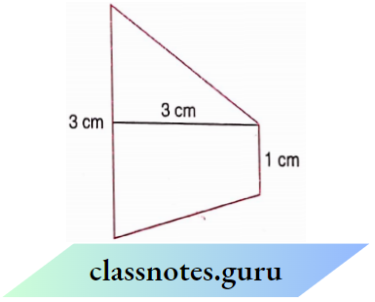
- 6 cm2
- 4 cm2
- 3 cm2
- 9 cm2
Solution: 1. 6 cm2
Area \(=\frac{(3+1) 3}{2}=6 \mathrm{~cm}^2\)
Question 15. The perimeter of the trapezium
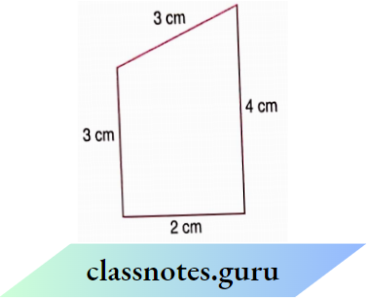
- 12 cm
- 24 cm
- 6 cm
- 18 cm.
Solution: 1. 12 cm
Perimeter = 3+ 3 + 2 + 4 = 12 cm
Question 16. The area of a rhombus is 60 cm2. One diagonal is 10 cm. The other diagonal is
- 6 cm
- 12 cm
- 3 cm
- 24 cm.
Solution: 2. 12 cm
⇒ \(\frac{1}{2}\)x 10 X = d260 => d2 = 12cm
Question 17. The area of a trapezium is 40 cm2. Its parallel sides are 12 cm and 8 cm. The distance between the parallel sides is
- 1cm
- 2cm
- 3cm
- 4cm
Solution: 4. 4cm
⇒ \(\frac{(12+8) d}{2}=\) – 40 =» d = 4cm
Question 18. 8 persons can stay in a cubical room. Each person requires 27 m3 of air. The side of the cube is
- 6m
- 4m
- 3m
- 2m
Solution: 1. 6m
Volume = 8 x 27 = 216 m3.
Side = 216 = 6 m
Question 19. If the height of the cuboid becomes zero, it will take the shape of a
- cube
- parallelogram
- circle
- rectangle
Solution: 4. rectangle
Height = \(\frac{80}{20}=4 \mathrm{~m} .\)
Question 20. The volume of a room is 80 m3. The area of the floor is 20 m2. The height of the 1 room is
- 1m
- 2m
- 3m
- 4m
Solution: 4. 4m
Question 21. The floor of a room is a square of side 6 m. Its height is 4 m. The volume of the room is
- 140 m3
- 142 m3
- 144 m3
- 145 m3
Solution: 3. 144 m3
Volume = 6x6x4 = 144 m3
Question 22. The base radius and height of a right circular cylinder are 14 cm and 5 cm, respectively. Its curved surface is
- 220 cm2
- 440 cm2
- 1232 cm2
- 2π x 14 x (14 + 5) cm2
Solution: 2. 440 cm2
Curved surface =\(2 \times \frac{22}{7} \times 14 \times 5\)
= 440 cm2.
Question 23. The heights of the two right circular cylinders are the same. Their volumes are respectively 16πm3 and 8lπm3. The ratio of their base radius
- 16:81
- 4:9
- 2: 3
- 9: 4.
Solution: 2. 4:9
⇒ \(\frac{\pi r_1^2 h}{\pi \pi_2^2 h}=\frac{16 \pi}{81 \pi} \Rightarrow \frac{r_1}{r_2}=\frac{4}{9}\)
Question 24. The ratio of the radii of two right circular cylinders is 1 : 2 and the ratio of their heights is 4 : 1. The ratio of their volumes is
- 1:1
- 1:2
- 2:1
- 4:1
Solution: 1. 1:1
⇒ \(\frac{r_1}{r_2}=\frac{\pi(1)^2 4}{\pi(2)^2 1}=1: 1 \text {. }\)
Class 8 Maths Chapter 9 Solutions with Explanation
Question 25. A glass in the form of a right circular cylinder is half full of water. Its base radius is 3 cm and its height is 8 cm. The volume of water is
- 18π cm3
- 36π cm3
- 9π cm3
- 36π cm3
Solution: 2. 36πcm3
Volume = \(\frac{1}{2} \pi \times 3 \times 3 \times 8=36 \pi \mathrm{cm}^3 .\)
Question 26. The base area of the right circular cylinder is 16ft cm3. Its height is 5 cm. Its curved surface area is
- 40π cm2
- 30π cm2
- 20π cm2
- 10π cm2
Solution: 1. 40π cm2
πr2 = 16π => r = 4 cm
Curved surface area = 2xπX4x5 = 40π cm2
Question 27. The base radius and height of a right circular cylinder are 5 cm and 10 Its total surface area is
- 150ft cm2
- 150 cm2
- 300ft cm2
- 300n cm2
Solution: 1.150π cm2
Total surface area = 2πr (h + r)
= 2π5 (10 + 5) = 150π cm2.
Mensuration True-False
Write whether the following statements are True or False:
1. The volume of a solid is the measurement of the space occupied by it: True
2. The areas of any two faces of a cuboid are equal: False
3. Two cuboids with equal volumes essentially have equal surface areas: False
4. The radii of two cylinders having the same volume are in the ratio 1 : 3. Then, the ratio of their heights is 9: 1: True
5. The volume of a cube is 216 cm3. Its surface area is 216 cm3: True
Mensuration Fill In The Blanks
1. The areas of any two faces of a cube are_______: Equal
2. The total surface area of a cube, whose volume is 1 cm3, is_____: 1cm2
3. 1 litre = _______cm3: 1000
4. 1 mm =_______ m : \(\frac{1}{1000} \mathrm{~m}\)
5. The ratio of radii of two cylinders is 1: 2 and heights are in the ratio 4: 5. Find the ratio of their volumes: 1:5
6. A metal sheet 64 cm long, 27 cm broad, and 8 cm thick is melted into a cube. Find the side of the cube: 24 cm
7. A cube of side 2 cm is cut into 1 cm cubes. What is the percentage increase in the volume after such a cutting: 0%
8. Find the area of the following figure: 10 cm2
